The Origin Of The
Fascist Mentality
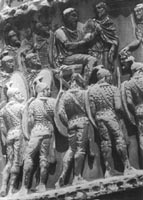
 Fascism is an ideology which
has its roots in Europe. The foundation of fascism
was laid by a number of European thinkers in
the19th century, and put into practice
in the 20th century by such countries
as Italy and Germany. Other countries, which were
influenced by fascism or adopted it, "imported"
the ideology from Europe. So, in order to examine
the roots of fascism, we must turn to the history
of Europe. Fascism is an ideology which
has its roots in Europe. The foundation of fascism
was laid by a number of European thinkers in
the19th century, and put into practice
in the 20th century by such countries
as Italy and Germany. Other countries, which were
influenced by fascism or adopted it, "imported"
the ideology from Europe. So, in order to examine
the roots of fascism, we must turn to the history
of Europe.
European history has gone through several
stages and periods. But, in the broadest sense, we
can divide it into three fundamental periods:
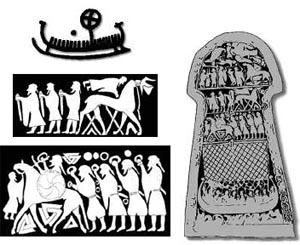  War and violence exercised an
important role in pagan culture, as indicated in
these figures of warriors on murals and
gravestones. |
1) The pre-Christian (pagan) period.
2) The period when Christianity assumed
cultural dominance in Europe.
3) The post-Christian (materialist) period.
The idea of a "Post-Christian" period may
strike many readers as odd, because Christianity
is still by far the majority religion in European
society. But Christianity is no longer a dominant
aspect of European culture: all that remains is
lip-service paid to it. The real ideologies and
concepts that now direct society have been formed,
not by the dictates of religion, but from the
materialist philosophy. This anti-religious
current began in the 18th century, and
came to dominate science and the realm of ideas in
the 19th. And, it was the
20th century when the catastrophic
results of materialism were finally witnessed.
In regards to these three periods, we can see
that fascism belongs to the first and third. In
other words, fascism is a product of paganism, and
was later reinforced with the rise of materialism.
Fascist ideology or practice was non-existent
throughout the thousand or so years when
Christianity dominated Europe. The reason being
that Christianity
is a religion of peace and
equality. Christianity, which calls people to
love, compassion, self-sacrifice, and humility, is
the complete antithesis of fascism.
Christianity is originally a divine religion,
incepted by the Prophet Jesus. After Jesus, it
departed from its original form with some
applications and interpretations. Nevertheless, it
has managed to maintain certain aspects of the
essence of the true religion, with concepts such
love, compassion, sacrifice, and humility, as set
out above.
Let us now have a brief look at pre-Christian
Europe and examine the roots of fascism.
FASCISTS IN THE PAGAN
WORLD
Essentially, as a pagan culture, religion in
pre-Christian Europe was polytheistic. Europeans
believed the false gods they worshipped
represented various forces or aspects of life, and
most important were the gods of war, much like
those who have appeared in just about every pagan
society.
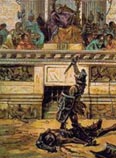 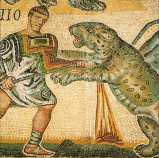 THE CULTURE OF VIOLENCE
IN THE PAGAN WORLD In pagan Rome, people were
torn apart by wild animals, or else made to
fight to the death in the Colosseum. The
audiences, who had fallen prey to paganism's
immorality and degeneracy, watched this violence
with great enjoyment and excitement.
|
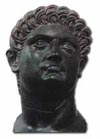 Nero: an example of a "fascist"
lover of violence from the pagan
world. |
This prestige the gods of war enjoyed in pagan
belief was the result of these societies'
regarding violence as sacred. Pagan peoples were
essentially barbaric and lived in a state of
permanent warfare. To kill and spill blood in the
name of their nation was seen as a sacred duty.
Savagery and violence of almost every kind could
find justification in paganism. There was no
ethical foundation to forbid violence or
brutality. Even Rome, thought of as the most
"civilized" state in the pagan world, was a place
where people were made to fight to the death or
torn to pieces by wild animals. The Emperor Nero
came to power by having countless numbers of
people killed, including his own mother, wife, and
stepbrother. He had Christians devoured by wild
animals in the arena, and tortured thousands of
people simply because of their beliefs. An example
of his cruelty was his setting the city of Rome on
fire, as he played the lyre and watched the
horrible scene from a window in his palace.
Though Rome was immersed in a culture of
violence, the barbarian and pagan nations of the
north, such as the Vandals, Goths, and Visigoths,
were still more savage. They strove to wreak
devastation on each other, as well as plundering
Rome. The pagan world was a place where violence
prevailed, where the use of brutality of every
kind was encouraged, and where there was no
consideration at all for ethics.
The best example in the pagan world of a
"fascist" system, in the modern sense, was the
Greek city-state of Sparta.
SPARTA: A MODEL FOR ALL
FASCISTS
 Lycurgus, the founder of the
Spartan State |
Sparta was a military state, dedicated to war
and violence, and alleged to have been founded by
Lycurgus in the 8th century BC. The
Spartans implemented highly regimented system of
education. Under the Spartan system, the state was
very much more important than the individual.
Peoples' lives were measured according to whether
or not they would be of use to the state. Strong,
healthy male children were dedicated to the state,
while unhealthy babies were abandoned to the
mountains to die. (This Spartan practice was taken
as an example by the Nazis of Germany, and it was
claimed, under the further influence of Darwinism,
that the sickly needed to be eliminated to
maintain a "healthy and superior race.") In
Sparta, parents were responsible for raising their
sons until the age of seven. From then, until the
age of 12, children were placed in teams of 15,
and those who stood out for their abilities were
selected to be leaders. Children spent their time
strengthening their bodies and preparing for war
by practicing sports.
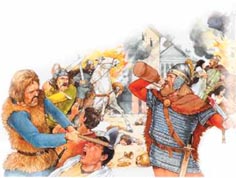 The pagan world possessed
a culture in which only brute force was seen to
matter. Like the Romans, northern barbarian
pagan tribes such as the Vandals, Goths and
Visigoths took great pleasure in
bloodshed. |
Literacy was not considered important, and
there was little interest in music or literature.
The only songs children were allowed to sing and
learn were those of war and violence. (The
education of children from the age of four under
the fascism of Mussolini and Hitler was very
similar). The Spartan custom was to indoctrinate
people in the spirit of war, at the expense of
art, literature, and education.
One of the most important thinkers to have
offered detailed statements about Sparta was the
famous Greek philosopher Plato. Although he lived
in Athens, which was governed democratically, he
was impressed with the fascist system in Sparta,
and in his books portrayed Sparta as a model
state.
 SPARTA: THE FIRST FASCIST STATE
The Greek city-state of Sparta was a brutal
war machine. Citizens were raised from infancy
to become ruthless warriors. Reading and
writing, music, art and literature were seen as
unimportant. The savage culture of the Spartans
became the inspiration behind the fascist
ideologues of the 19th and 20th
centuries. |
Because of Plato's fascist tendencies, Karl
Popper, one of the foremost thinkers of
the20th century, in his famous book,
The Open Society and Its Enemies, describes him as
the first source of inspiration for oppressive
regimes, and an enemy of open society. In support
of his contention, Popper refers to how Plato
calmly defended the killing of infants in Sparta,
and describes him as the first theoretical
proponent of "eugenics":
...[I]t is important that the master class
should feel as one superior master race. 'The race
of the guardians must be kept pure', says Plato
(in defence of infanticide), when developing the
racialist argument that we breed animals with
great care while neglecting our own race, an
argument which has been repeated ever since.
(Infanticide was not an Athenian institution;
Plato, seeing that it was practised at Sparta for
eugenic reasons, concluded that it must be ancient
and therefore good.) He demands that the same
principles be applied to the breeding of the
master race as are applied, by an experienced
breeder, to dogs, horses or birds. 'If you did not
breed them in this way, don't you think that the
race of your birds or dogs would quickly
degenerate?' Plato argues; and he draws the
conclusion that 'the same principles apply to the
race of men'. The racial qualities demanded from a
guardian or from an auxiliary are, more
specifically, those of a sheep-dog. 'Our
warrior-athletes .. must be vigilant like
watch-dogs', demands Plato, and he asks: 'Surely,
there is no difference, so far as their natural
fitness for keeping guard is concerned, between a
gallant youth and a well-bred dog?'3
These views of Plato, who regarded human beings
as a species of animal, and proposed that they
should be "evolved" through "forced mating," came
to the fore once again with the advent of
Darwinism in the 19th century, and were
implemented by the Nazis in the20th. We
shall be examining this in the pages that
follow.
While defending the Spartan model, Plato also
advanced another aspect of fascism, the state use
of repression to administer society. In Plato's
view, this pressure should be so comprehensive
that people should be unable to think of anything
apart from the orders of the state, and behave in
complete adherence to state policy, forsaking the
use of their intelligence and free will. The
following words of Plato, quoted by Popper as a
complete statement of the fascist mentality,
describe the structure of fascist order:
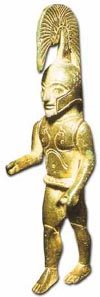 A bronze statue of a
Spartan soldier going to
war. |
 A Spartan
soldier |
The greatest principle of all is that nobody,
whether male or female, should be without a
leader. Nor should the mind of anybody be
habituated to letting him do anything at all on
his own initiative; neither out of zeal, nor even
playfully. But in war and in the midst of peace-to
his leader he shall direct his eye and follow him
faithfully. And even in the smallest matter he
should stand under leadership. For example, he
should get up, or move, or wash, or take his meals
.. only if he has been told to do so. In a word,
he should teach his soul, by long habit, never to
dream of acting independently, and to become
utterly incapable of it.4
These ideas and practices, promoted by the
Spartans, as they were by Plato, exemplify the
fundamental characteristics of fascism-the
perception of human beings as mere animals,
fanatical racism, the promotion of war and
conflict, state-sponsored repression, and "formal
indoctrination."
Similar fascistic practices are also
discoverable in other pagan societies. The system
set up by the pharaohs, the rulers of ancient
Egypt, is in certain aspects comparable to Spartan
fascism. The Egyptian pharaohs built up state
systems founded on ideals of military discipline,
and used them to oppress even their own people.
Rameses II, the tyrannical Egyptian ruler, who is
believed to have lived in the time of the Prophet
Moses, ordered that all male Jewish children be
killed, a cruelty reminiscent of the infanticide
in Sparta, and the psychological forms of
oppression he inflicted on his own subjects also
recalls the fascistic system described by Plato.
As God revealed in the Koran, Pharaoh offered his
subjects the following tyrannical ultimatum: "...I only show you what I see
myself and I only guide you to the path of
rectitude." (Koran, 40:29) And he
threatened those magicians who rejected his pagan
beliefs and led to the true religion by following
Moses, "...Have you believed
in him before I authorized you to do so?...I will
cut off your alternate hands and feet and then I
will crucify every one of you." (Koran,
7:123-124)
FASCISM'S RETREAT IN THE FACE OF
RELIGION
The fascistic pagan culture which dominated
Europe disappeared in stages with the spread of
Christianity in the 2nd and 3rd centuries AD,
first to Rome, and then to all of Europe.
Christianity carried to European society the basic
ethical characteristics of the true religion
revealed to man by the Prophet Jesus. Europe,
which had once encouraged violence, conflict and
bloodshed as sacred, and been composed of
different tribes, races and city-states constantly
at war with one another, underwent an important
change.
1) Racial and tribal wars
disappeared: In the pagan world, all tribes
and races saw each other as enemies, and there was
constant fighting between them. Each pagan society
had its own gods and totems which it invented,
waging war in their name. With the coming of
Christianity, there was a single belief, culture,
and even language in Europe as a whole, thus the
conflicts of the pagan world came to an end.
2) Peace and compassion
came to be considered sacred, instead of
violence: In pagan societies, inflicting
bloodshed, suffering and torture was seen as
heroic, actions that appeased the imaginary "gods
of war." Under Christianity however, European
societies learned that people should love each
other and exercise compassion (even for their
enemies), and that the shedding of blood was a
great sin in the sight of God.
3) The perception of human
beings as a species of animal disappeared:
The Spartans regarding their warriors as
equivalent to "watch-dogs" was an extension of the
"animist" belief widespread in pagan societies.
Animism implied ascribing a soul to nature and
animals. According to animism, there was no
difference between a human being and an animal, or
even a plant. But when religion came to
predominate, this superstition disappeared, and
European societies realized that human beings
possessed a soul given to them by God, and were
completely different from animals, and could not,
therefore, be subject to the same laws.
These three aspects of paganism-racism,
bloodshed, and equating human beings with
animals-are also the basic characteristics of
fascism. In Europe, they were vanquished by
Christianity. In the Middle East, the same victory
was achieved by Islam over Arab paganism. Before
the advent of Islam, the Arabs (and other Middle
Eastern and Central Asian societies) were warlike,
blood-thirsty, and racist. The Spartans' barbaric
"abandonment of unwanted children to die" was
adopted by the pagan Arabs, in the form of burying
their female children alive. The Koran mentions
this savage practice:
When the baby girl buried
alive is asked for what crime she was killed.
(Koran, 81: 8-9)
When any of them is given
the good news of (the birth of a daughter) the
very thing which he himself has ascribed to the
All-Merciful his face darkens and he is furious.
(Koran, 43:17)
The Arabs, and other Middle Eastern and Central
Asian cultures, were only transformed into
peaceful, civilized, intelligent societies opposed
to bloodshed after they were enlightened by Islam.
Thus they were freed from the old tribal wars and
nomadic savagery, and found peace and stability in
religion.
NEO-PAGANISM AND THE BIRTH OF
FASCISM
 Aristo |
 THE LIBERTY CAP: The
picture below was thought to represent the unity
and indivisibility of the republic established
after the French revolution. In this and many
other illustrations of the period, the symbol of
the liberty cap was used to represent the
revolution, but was actually a legacy of the
pagan myth of Mithras from the ancient
world. |
Although European paganism was suppressed by
Christianity, it did not die out. It survived
under the guise of various teachings, movements,
and secret societies, such as the Freemasons, and
re-emerged in a definite form in Europe in the
16th and 17th centuries. A
number of European thinkers, influenced by the
works of ancient Greek philosophers, such as Plato
or Aristotle, began to revive concepts from the
pagan world.
This neo-pagan current became increasingly
influential, and in the 19th century,
surpassed Christianity and imposed itself on
Europe. It will be useful to examine the main
outline of this lengthy process here, without
necessarily going into details.
The vanguard of neo-pagan movement were those
thinkers known as "humanists." Influenced by
ancient Greek sources, they tried to spread the
pagan philosophies of such philosophers as Plato
and Aristotle. The belief they professed in the
name "humanism" was a perverted philosophy that
ignored the existence of God and man's
responsibilities to Him, but instead considered
man a great, superior, and independent being. The
influences of humanism took on further aspects
with the philosophy of the Enlightenment in the
17th and 18th centuries.
 In this picture, painted in honor
of Jean Jacques Rousseau after the French
Revolution, are symbols of ancient paganism,
such as the liberty cap and the tied
staves. |
Enlightenment philosophers were influenced by
and fiercely defended materialism, an idea which
developed in ancient Greece. (Materialism is a
dogmatic philosophy put forward by such Greek
thinkers as Leucippus and Democritus, positing
that only matter exists).
The rebirth of paganism is clearly evident in
the French Revolution, widely accepted as the
political end-product of Enlightenment philosophy.
The Jacobins, who led the bloody "terrorist"
period of the French Revolution, were influenced
by paganism, and nurtured a great hatred for
Christianity. As a result of intensive Jacobin
propaganda during the fiercest days of the
revolution, the "rejection of Christianity"
movement became widespread. In addition, a new
"religion of reason" was established, which was
based on pagan symbols rather than Christianity.
Its first signs were seen in the "revolutionary
worship," on the Festival of Federation on July
14, 1790, which were then widely disseminated.
Robespierre, the ruthless leader of the
Jacobins, brought about new rules for
"revolutionary worship," setting out their
principles in a report under the name "Cult of the
Supreme Being." The most significant outcome of
these developments was the conversion of the
famous Notre Dame Cathedral into a "temple of
reason."
  The Cordeliers Club card
belonging to Robespierre, ruthless leader of the
French revolution. Pagan symbols such as the red
cap and a bundle of rods strapped around an axe
are particularly evident. Robespierre
(right) |
The Christian icons on its walls were torn
down, and a female statue known as the "goddess of
reason" was erected in the center of it, in other
words, a pagan idol.
These pagan tendencies were portrayed among the
revolutionaries by a number of symbols. The
liberty cap worn by the revolutionary guards of
the French Revolution, and which often became a
symbol of the revolution, descended from the pagan
world and the worship of Mithras.5
The rebirth of paganism, and the beginning of
its intellectual dominance over Europe, also led
the way
to a rebirth of fascism, itself a
system rooted in the pagan world. In fact, Nazi
Germany, with its system reminiscent of that
practiced in Sparta, was based on paganism.
Towards this development, a number of fundamental
cultural changes were necessary between the French
Revolution, at the end of the 18th
century, and Nazi Germany, at the beginning of the
20th. These important changes
were
brought about by a number of thinkers
during the 8th century. The most
important of these was Charles Darwin.
DARWINISM AND THE REVIVAL OF THE
PAGAN SUPERSTITION OF "EVOLUTION"
One of the superstitions to survive from
paganism, but which only began to be revived in
Europe in the 18th and 19th
centuries, was the "theory of evolution," a theory
which maintained that all living things came into
existence as the result of pure chance, and then
developed from one to another.
 Thales, one of the first
proponents of the myth of
"evolution." |
Unaware of the existence of God, and
worshipping false idols which they themselves
devised, pagans answered the question of how life
came about with the concept of "evolution." This
notion is first seen in inscriptions from ancient
Sumeria, but was given shape in ancient Greece.
Pagan philosophers such as Thales, Anaximander and
Empedocles, claimed that living things, in other
words human beings, animals and plants, formed
themselves from such inanimate substances as air,
fire and water. According to their theories, the
first living things suddenly emerged in water and
then adapted to the land. Thales had spent time in
Egypt, where the superstition that "living things
formed themselves out of mud" was widespread. The
Egyptians believed that in this way the frogs
which appeared when the waters of the Nile receded
were formed.
Thales adopted the superstition and attempted
to present a number of arguments on its behalf,
proposing that all living things came into
existence by and of themselves. These claims of
his were based solely in theory, not on experiment
and observation. Other ancient Greek philosophers
employed the same method.
Anaximander, a student of Thales, developed the
theory of evolution, giving rise to to two
important modes of Western thought. The first of
these was that the universe had always existed and
will continue to exist into eternity. The second
was the idea that living things evolved from each
other, an idea which had slowly begun to take
shape in Thales' time. The first written work to
discuss the theory of evolution was the classical
poem On Nature, in which Anaximander wrote that
creatures arose from slime that had been
evaporated by the sun. He thought that the first
animals lived in the sea and had prickly, scaly
coverings. As these fish-like creatures evolved,
they moved onto land, shed their scaly coverings,
and became humans.6
Books on philosophy describe how Anaximander
shaped the foundation of the theory of
evolution:
We find that Anaximander of Miletus (611
B.C.-546 B.C.) advanced the traditional
evolutionary idea, already quite common in his
day, that life first evolved from a type of
pre-biotic soup, helped along a bit by the rays of
the sun. He believed that the first animals
developed from sea slime which had been evaporated
by the sun rays. He also believed that men were
descended from fish.7
| That is because God-He is the
Truth, and what you call upon besides Him is
falsehood. God is the All-High, the Most Great.
(Koran, 31:30) |
In short, one of the two fundamental components
of Darwinism, the claim that living things evolved
from each other as a result of coincidences, was
the product of pagan philosophy. The second
important element of Darwin's theory, "the
struggle for survival," was also a pagan belief.
It was the Greek philosophers who first suggested
there was a war for survival between living things
in nature.
 With his theory defending war,
conflict and the struggle for survival between
the races, Charles Darwin prepared the
ideological foundation of
fascism. |
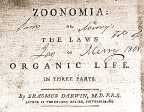 Erasmus Darwin's book
Zoonomia. |
The notion of evolution, which the pagan
philosophers had construed, not by experiment and
observation, but by abstract reasoning, began to
be reiterated in 18th century Europe.
In pagan thought, the concept of evolution was
called "the Great Chain of Being," an idea that
influenced such early defenders of evolutionary
theory as the French scientists Benoit de Maillet,
Pierre de Maupertuis, Comte de Buffon and Jean
Baptiste Lamarck. In his Histoire Naturelle,
Buffon reveals himself as "an exponent of the
doctrine of the Great Chain of Being, with man
being placed at the tope of the Chain."8
Buffon's evolutionist views were passed on to
Lamarck, and eventually inherited by Charles
Darwin.
Charles Darwin's grandfather, Erasmus Darwin,
was an evolutionist who adhered to pagan beliefs.
Erasmus Darwin was one of the masters at the
famous Canongate Kilwining Masonic lodge in
Edinburgh, Scotland. He also had close connections
to the Jacobins in France, and the Masonic
organization of the Illuminati, whose founding
principle was the hatred of religion. From the
research he carried out in his eight-hectare
botanical garden, he developed the ideas that
would later go on to shape Darwinism, collected
together in his books The Temple of Nature and
Zoonomia. The concept of "the temple of nature"
that Erasmus employed was a testament to the pagan
beliefs he adopted, a repetition of the old pagan
belief that nature possesses a creative force.
DARWINISM PREPARED THE FOUNDATION
FOR FASCISM
The myth of evolution, a legacy of Sumerian and
Greek paganism, was introduced into the Western
agenda with Charles Darwin's The Origin of
Species, published in 1859. In this work, as in
The Descent of Man, he discussed certain pagan
concepts that had disappeared in Europe under
Christianity, and gave them "justification" under
the guise of science. We can outline these pagan
concepts which he attempted to justify, thus
preparing the groundwork for the development of
fascism, as follows:
1) Darwinism provided the
justification for racism: In the subtitle
to The Origin of the Species, Darwin wrote: "The
Preservation of Favoured Races in the Struggle for
Life." With these words, Darwin was claiming that
certain races in nature are more "favored" than
others, in other words, that they were superior.
He revealed this dimension of his ideas regarding
human races in The Descent of Man, where he
proposed that European white men were superior to
races such as Africans, Asians and Turks, and were
permitted to enslave them.
2) Darwinism provided a
justification for bloodshed: As we have
seen, Darwin proposed that a deadly "struggle for
survival" takes place in nature. He claimed that
this principle applied to both societies and to
individuals, that it was a struggle to the death,
and that it was quite natural for different races
to try to eliminate others for its own sake. In
short, Darwin described an arena where the only
rule was violence and conflict, thus replacing the
concepts of peace, cooperation, self-sacrifice,
that had spread to Europe with the advent of
Christianity. Darwinism thus resurrected the
notion of the "arena," an exhibition of violence
devised in the pagan world (the Roman
Empire).
 The American historian Paul
Crook's book 'Darwinism, War and
History' |
3) Darwinism brought the
concept of eugenics back into Western
thought: The concept of maintaining racial
supremacy through breeding, known as eugenics,
which the Spartans had implemented, and which
Plato defended by the words, "Our warrior-athletes
must be vigilant like watch-dogs," re-emerged in
the Western world with Darwinism. Darwin devoted
whole chapters in The Origin of Species to
discussing the "improvement of animal races," and
maintained, in The Descent of Man, that human
beings were a species of animal. Some time later,
Darwin's cousin, Francis Galton, was to take his
uncle's claims a step further, and put forward the
modern theory of eugenics. (Nazi Germany would be
the first state to implement eugenics as official
policy).
As we have seen, Darwin's theory seems to be a
concept that concerns only the science of biology,
but it actually formed the basis for a totally new
political outlook. Within a very short time, this
new attitude was redefined as "Social Darwinism."
And as many historians have come to accept, Social
Darwinism became the ideological basis of fascism
and Nazism.
The effect of Darwinism's portrayal of war and
conflict as necessary has been analyzed in great
detail in Paul Crook's Cambridge University
publication Darwinism, War and History: The Debate
over the Biology of War from 'The Origin of
Species' to the First World War. Crook has made it
clear that by presenting war as a "biological
necessity," Darwinism formed both the formal
justification for the First World War, as well as
for various other warlike tendencies in fascism.
Crook writes:
Darwinist discourse conferred approval on a
range of doctrines glorifying power, status,
elitism, conquest and repression. Differences
between cultures, genders, classes and races were
reduced to fixed biological differences, imprinted
in humans during eons of selective struggle.
Darwin's conflict model generated militarist and
racist extrapolations that conferred approval on
war and imperial struggle as 'biological
necessities'.9
From such [Darwinist] assumptions, a variety of
unpleasant consequences could be derived... War is
rationalised... As Frederick Wertham has argued,
if violence 'is all in human nature, and if we are
all guilty, then nobody is guilty. And if we are
all responsible, no man is responsible' ...The
First World War was portrayed as the final
vindication of the mythology of bestiality,
encoded anew in terms of neo-Darwinian genetics
and instinct theory.10
| You who believe! Enter absolutely
into peace (Islam). Do not follow in the
footsteps of Satan. He is an outright enemy to
you. (Koran, 2:208) |
Darwin thought of using Hobbes's phrase 'war of
nature' as a heading to his chapter on struggle in
his projected 'big book' Natural Selection ...He
spoke of creatures 'overmastering' one another:
'through his continual use of highly dramatic
language representing the life of organisms in
nature as some heroic war, with attendant battles,
victories, famine, dearth, and destruction, Darwin
creates the image of a great literal struggle for
existence - an image which pervades the Origin.'11
As Crook has stated, Darwin not only proposed
that human beings were a "species" descended from
animals, but portrayed war and conflict as "the
origin of species." This fallacy would be the
justification for the promotion of war and the
ideology of conflict, in fact, for the growth of
fascism itself.
FRIEDRICH NIETZSCHE: AN ILL MIND
WHO PRAISED VIOLENCE
There was another 19th century
thinker influenced by the neo-paganism attendant
to Darwinism, and who expanded on it, thus helping
to establish the foundation for fascism: The
German philosopher Friedrich Nietzsche.
  NIETZSCHE, A FANATICAL OPPONENT OF
RELIGION NIETZSCHE, A FANATICAL OPPONENT OF
RELIGION
Nietzsche was influenced by the
neo-pagan ideas brought about by the popularity
of Darwin's theory, and laid the foundations of
fascism. Nietzsche was a fierce enemy of
religion, and his books Anti-Christ and Thus
Spake Zarathustra, are clear evidence of his
interest in
paganism. |
Nietzsche was born in a village near Leipzig in
1844, and was fascinated by Greek culture,
learning Greek at an early age. In 1868, he began
studying philosophy in the Swiss city of Basel.
Nietzsche hated divine religions, such as
Christianity, Islam and Judaism, but was
fascinated by the pagan culture of ancient Greece.
He formed a close friendship in Basel with Wagner,
the best-known composer of the age. Wagner, who
had come to fame with his Die Götterdämmerung (The
Twilight of the Gods), was a German racist who was
also fascinated by pagan culture and hated divine
religions. (Wagner would be regarded as Germany's
greatest cultural genius throughout the Hitler
period).
 The German racist Wagner, known
for his reverence of European paganism and
hatred of divine religions, was regarded in
Hitler's time as the greatest artistic
genius. |
Nietzsche's publisher, Peter Gast, called
Nietzsche "one of the fiercest anti-Christians and
atheists."12
Another testament to Nietzsche's hatred of
religion is the title of his book Anti-Christ. In
his book Thus Spake Zarathustra, he tried to set
up an ethical system beyond divine religion.
According to H. F. Peters, Nietzsche's biographer,
his philosophy rested on Roman and Greek paganism,
and in his writings he called for "a new Caesar"
to transform the world.13
 Nietzsche had a
particular hatred of the ethical views of
Christianity, Islam and Judaism. In his opinion,
concepts such as love, compassion and humility,
must be abandoned and replaced with a so-called
"master morality" which accepted the warlike and
ruthless state of nature. In Thus Spake
Zarathustra, he wrote, "Of all that is written I
love only what a man has written with his blood.
Write with blood, and you will experience that
blood is spirit."14 Nietzsche had a
particular hatred of the ethical views of
Christianity, Islam and Judaism. In his opinion,
concepts such as love, compassion and humility,
must be abandoned and replaced with a so-called
"master morality" which accepted the warlike and
ruthless state of nature. In Thus Spake
Zarathustra, he wrote, "Of all that is written I
love only what a man has written with his blood.
Write with blood, and you will experience that
blood is spirit."14
Nietzsche was also a racist. He maintained that
one part of mankind was composed of übermensch
(superman), and that the others had to serve and
obey them. Furthermore, he claimed that these
so-called "supermen" would found an aristocratic
world order, a theory which was put into practice
by Hitler's armies at the start of the Second
World War in 1939.
These two aspects of Nietzsche's philosophy,
his racism and reverence for violence, are allied
closely to Darwinism. Nietzsche's thought was in
fact strongly influenced by Darwin. Darwin's
discrimination between the different races
conformed closely to Nietzsche's perception of
"superior and inferior peoples." Nietzsche also
adapted his hatred of religion with the atheism of
Darwin.
In his book Darwin's Dangerous Idea, the
Darwinist writer Daniel C. Dennett describes
Darwin's influence on Nietzsche in the following
way: "Friedrich Nietzsche saw …an even more cosmic
message in Darwin:...If Nietzsche is the father of
existentialism, then perhaps Darwin deserves the
title of grandfather."15
Dennett explains in great detail how Darwin and
Nietzsche's ideas run parallel, and although
Nietzsche seems to criticize Darwin in some of his
writings, he gives many examples where Nietzsche
clearly approves of Darwinist thought.
| The likeness of those who
disbelieve is that of someone who yells out to
something which cannot hear-it is nothing but a
cry and a call. Deaf-dumb-blind. They do not use
their intellect. (Koran, 2:171)
|
  According to the
historian W. Cleon Skousen, Hitler's Mein Kampf
was as if "Nietzsche was speaking from the
dead." |
After Nietzsche's death, the most important
exponent of his philosophy was his sister,
Elisabeth Nietzsche. She stood out as an avowed
supporter of Nazi ideology in Hitler's Germany,
and announced that her brother's model of the
"Superman" had been brought to life by Hitler.16
Nietzsche's influence on Nazi ideology is a
reality that has been stressed by a great many
historians. W. Cleon Skousen writes that, when
"Hitler wrote Mein Kampf, it was as though
Nietzsche was speaking from the dead."17
Another historian, George Lichtheim, writes, "It
is not too much to say that but for Nietzsche the
SS-Hitler's shock troops and the core of the whole
movement-would have lacked the inspiration to
carry our their programs of mass murder in Eastern
Europe."18
As the historian H. F. Peters puts it, many
have cursed Nietzsche as "the father of
fascism."19
In his book, The Myth of the 20th
Century, the Nazi ideologue Alfred Rosenberg
openly praised Nietzsche. Hitlerjugend (Hitler
Youth), the youth wing of the
Nazi movement,
took Nietzsche's Thus Spake Zarathustra as a
sacred text. Adolf Hitler had a special monument
erected in Nietzsche's memory, and incepted the
foundations of an educational center and library
"where German youth could be taught Nietzsche's
doctrine of a master race."20
Finally, the Friedrich Nietzsche Memorial Building
was opened by Hitler in August 1938.
 
THE NAZI MASSACRES IN
EASTERN EUROPE
According to historian George
Lichtheim, Nietzsche was the main inspiration
behind Hitler, whose SS units were responsible
for terrible massacres of Jewish and Slav
populations in eastern
Europe.
|
Nietzsche's influence was not limited to
Germany, it was also important in Italy, the
birthplace of fascism. The poet Gabriele
D'Annunzio, who may be regarded as the inspiration
behind Mussolini, was greatly influenced by
Nietzsche's philosophy.21
Historians note that D'Annunzio's successor,
Benito Mussolini acknowledged a debt of gratitude
to Nietzsche as well.22
 Hitlerjugend (The Hitler
Youth), the Nazis' youth wing, considered
Nietzsche's Thus Spake Zarathustra to be a
"sacred text." |
The disasters inflicted upon mankind by
fascism, which Nietzsche had inspired, provide
historical evidence of just how harmful were the
German philosopher's Darwinist ideas. Nietzsche,
who opposed the divine morality that God revealed
to mankind to show it the true path, and who
proposed taking mankind to the modern age by
replacing that morality with a brutal and
oppressive society, had put forward Darwin's idea
that man is a species of animal, and divided man
into superior and inferior races, is the best
example of the dark reality into which a lack of
religion draws individuals and societies.
Moreover, Nietzsche's life itself serves a
warning.
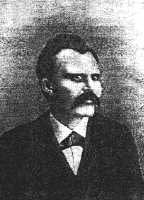 Dr. P. J. Mobius (above)
stated that Nietzsche had a "diseased brain" and
warned people against the ideas produced by that
brain. |
At 44 he was taken to a mental hospital, where
his illness grew steadily worse, until he died
raving mad. In 1902, a doctor called P. J. Mobius
warned people "that they should beware of
Nietzsche, for his works were the products of a
diseased brain."23
But the Germans had great respect for the diseased
philosophy of this disturbed mind, and so Nazi
Germany was born.
Nietzsche died of syphilis in a state of mental
decay in a lunatic asylum. His private life was no
less troubled or diseased than his
philosophy.
Like all those who have ever denied the
existence of God, he met a very unpleasant end.
Do not let those who rush
headlong into disbelief sadden you. They do not
harm God in any way. God desires to assign no
portion to them in the hereafter. They will have a
terrible punishment. Those who sell belief for
disbelief do not harm God in any way. They will
have a painful punishment. Those who disbelieve
should not imagine that the extra time We grant to
them is good for them. We only allow them more
time so they will increase in evildoing. They will
have a humiliating punishment. (Koran,
3:176-178)
FRANCIS GALTON: THE INSPIRATION
BEHIND EUGENIC KILLINGS
Another important 19th century
ideologue, who helped lay the foundations of
20th century fascism, was Francis
Galton, known as the founder of the theory of
"eugenics."
We have already discussed the concept of
eugenics. It saw people as a species of animal and
was the product of a mentality that imagined that
the same rules applied to human beings as to
animals. It held the belief that the human race
could be developed by "breeding methods," as with
dogs or cattle. According to the theory, society's
sick and deformed must be prevented from
multiplying, (if necessary, they should even be
killed), and healthy individuals should
"reproduce" as much as possible to ensure strong
and healthy later generations. This policy was one
that had been implemented by the warrior
city-state of Sparta, and defended by Plato.
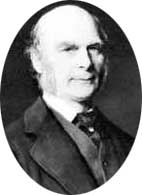 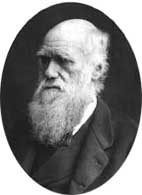
Francis Galton
Charles Darwin
Francis Galton
(left), Charles Darwin's (right) cousin, was
influenced by Darwin and the French physicist
Paul Broca, himself another evolutionist. Galton
put forward the theory of "eugenics," which
suggested that some races were superior to
others and that the strong should be kept
uncontaminated by the
weak. |
With the domination of Christianity, eugenics
had found itself relegated to the dusty shelves of
history. Until Darwin's The Origin of Species was
published. Darwin devoted the opening chapters of
his book to the subject of raising animals, drew
attention to those breeders who raised more
productive breeds of horses and cattle, and then
proposed, later on in the book, that these methods
could be applied to human beings. Ultimately, it
was Darwin's cousin, Francis Galton, who widened
the road of eugenics opened by his uncle, and who
brought the subject onto the world stage by
formulating it into a comprehensive program.
As we might imagine, Galton was a fierce
supporter and follower of Darwin. In his
autobiography Memories of My Life, he writes:
The publication in 1859 of The Origin of
Species by Charles Darwin made a marked epoch in
my own mental development, as it did in that of
human thought generally. Its effect was to
demolish a multitude of dogmatic barriers by a
single stroke, and to arouse a spirit of rebellion
against all ancient authorities whose positive and
unauthenticated statements were contradicted by
modern science.24
The concepts that Galton denigrated as
"dogmatic barriers" and "ancient authorities" were
religious systems and beliefs. In other words,
Darwin was the reason for Galton's "great turning
point," giving up his beliefs, and turning to the
atheism and the racism, remnants of paganism.
Other than Darwin, Galton was also influenced
by another evolutionist ideologue, the French
physicist Paul Broca, who proposed that human
intelligence was directly related to brain size
and, hence, to the size of the head. In order to
allegedly "prove" this, he tore up Paris
graveyards and measured hundreds of skulls. Galton
united Broca's superstition about brain size-which
would subsequently be proved to be utterly
wrong-and Charles Darwin's "animal breeding"
philosophy. The result was the theory of
"eugenics," being that certain races of humanity
are superior to others, and that those superior
must be kept uncontaminated by those inferior.
|
THE RACIST
SCIENCE OF DARWINISM: SKULL MEASUREMENT
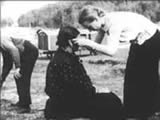 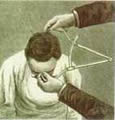  
Paul
Broca, one of several Darwinists to have
influenced Francis Galton, proposed that human
intelligence was directly related to brain size,
and consequently, to the size of the head. In
order to "prove" his theory, he dug up Paris
graveyards and measured hundreds of skulls.
Although Broca's theories were subsequently
proved wrong, skull measurements were carried
out in a number of countries, particularly
Germany. "Superior people" were supposedly
identified from these
measurements. |
Galton first published his ideas in 1869, in
his book Hereditary Genius. It discusses a number
of "geniuses" in British history and claims that
they bore pure racial characteristics. (Among
these "geniuses," he did not neglect to include
his uncle, Charles Darwin). In accordance to his
claim, Galton then suggested that the English
nation possessed an inherently superior blood to
other races, and that steps needed to be taken to
protect that blood from contamination. These
theories he considered to be applicable not just
to the British, but to all races. The Canadian
author Ian Taylor has this to say in his book In
the Minds of Men, in which he considers the social
effects of Darwinism:
 A document describing the
measures applied in California, one of the
American states which implemented the racist
"Sterilization Laws" in the
1930s. |
He [Galton] was now left with the claim that
certain races were inherently superior and that
their superiority was fixed forever from the past
as well as into the future… The conclusion to
Galton's argument then followed that, for the sake
of mankind's future, pollution of the precious
superior gene pool by interbreeding with inferior
stock had to be stopped at all costs.25
Galton proposed that legal measures needed to
be taken to prevent "inferior races polluting the
superior." In his view, marriages needed to be
legally regulated. To name his racist-evolutionist
theory, Galton looked to the pagan world which had
once practiced the same ideology. It was Galton
who coined and first used the word "eugenics,"
from the Greek for "good birth." Inevitably, those
who believed in Darwinism, also believed in
eugenics. Finally, the Eugenics Education Society
was established in 1907, based at the statistics
department of University College, London. In 1926,
the name was simplified, and it became the
"Eugenics Society."
The Eugenics Society maintained that all
handicapped people should be "sterilized." Charles
Darwin's son, Leonard Darwin, was president of the
organization between 1911 and 1928, and its most
active member.
After Great Britain, eugenics began to attract
supporters in the United States. Evolutionist
circles there carried out a great deal of
propaganda on the subject in the 1920s and 30s,
and certain states passed the laws known as
"Sterilization Laws." These laws allowed men and
women believed to be genetically weak or sick to
be sterilized.
These laws are now seen in the United States as
an example of the detriment of racism. What is
more, the idea is now seen as a superstition,
totally at variance with the scientific facts. The
recent human genome project has shown that the
genetic differences between races and individuals
are very small, and that it is stupid to even
attempt to construct any reproduction policy based
on them. Human races were created equal by God. In
the Koran, God says:
Mankind! We created you
from a male and female, and made you into peoples
and tribes so that you might come to know each
other. The noblest among you in God's sight is
that one of you who best performs his duty. God is
All-Knowing, All-Aware. (Koran, 49:13)
The weak and genetically sick must be treated
with affection and compassion, protected and
nurtured, not "sterilized." But instead of this
approach, revealed to us by God as a religious
moral duty, the Western world, at the beginning of
the20th century, turned to eugenics, a
product of paganism and the theory of evolution.
And, the scale of the savagery that this
pagan-evolutionary theory led to will be revealed
when we consider the case of Germany.
ERNST HAECKEL: THE NAZIS 'RACIST
THEORETICIAN
The last name along the path from Darwin to the
Nazis that we need to consider is the zoologist
Ernst Haeckel, Germany's best-known Darwinist and
a fanatical supporter of eugenics.
In the history of science, Haeckel is known for
his theory that "ontogeny recapitulates
phylogeny." According to this evolutionary theory,
Haeckel was claiming that embryonic development
repeats "evolutionary history." He thought that
the stages of embryonic development repeated the
adult stages of the ancestors of a species. In
order to support his theory, which he developed
under the influence of Darwin, Haeckel made a
number of drawings of embryos, in which, it was
later realized, he had made deliberate
distortions, and that his theory was a forgery.
Haeckel was a charlatan who used falsified
evidence to make Darwinism scientifically
acceptable.
 Ernst
Haeckel |
Another instance of Haeckel's erroneous science
is the theory of eugenics. He adopted the theory,
from such names as Charles Darwin, Francis Galton
and Leonard Darwin, and took it further, by
suggesting a return to the Spartan model of
ancient Greece: In other words, to murdering
children! In his book Wonders of Life, Haeckel
proposed the "destruction of abnormal new born
infants" without hesitation, and claimed that it
could not "rationally be classed as murder",
becaýse these children were not yet conscious.26
Haeckel wanted all the sick and deformed, who
may be an obstacle to the so-called evolution of
society, not just children, to be eliminated as a
requirement of the "laws of evolution." He opposed
treatment for the sick, claiming that this
obstructed the workings of natural selection. He
complained that "Hundreds of thousands of
incurables-lunatics, lepers, people with cancer
etc-are artificially kept alive in our modern
communities…without the slightest profit to
themselves or the general body." He further
recommended that a commission should be set up to
decide the fate of individuals. Upon the decision
of the commission the "'redemption from evil'
should be accomplished by a dose of some painless
and rapid poison."27
This barbarism, upon which Haeckel built his
theory, was to be put into practice in Nazi
Germany. Shortly after coming to power, the Nazis
instituted an official policy of eugenics. The
mentally ill, the deformed, the blind from birth,
and those with genetic diseases, were gathered up
in "sterilization centers." These people were
regarded as parasites that spoiled the purity of
the German race and its evolutionary progress.
Some time after being separated from society, they
were eventually killed under special orders from
Hitler.
It is a well known fact, pronounced by many
historians who have studied the subject, that
Ernst Haeckel's ideas, and the Darwinist ideology
in general, were the ideological basis of Nazism.
In his book The Scientific Origins of National
Socialism: Social Darwinism in Ernst Haeckel and
the German Monist League, the American historian
Daniel Gasman presents extensive proof of this.
According to Gasman, Haeckel "became one of
Germany's major idealists for racism, nationalism
and imperialism."28
Haeckel left Nazism an organizational and an
ideological legacy. On the one hand he developed
the theory of eugenics and racism, and on the
other he founded the "Monist League," an atheist
association, and this played a major role in the
effect the Nazis had on the educated section of
society.
THE IDEA OF MAN AS
AN "ANIMAL," THE IDEOLOGICAL FOUNDATION BEHIND
THE NAZI MURDERS
 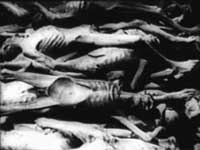 Eugenic killings, which had
been defended by Ernst Haeckel, and were put
into practice by the Nazis after 1933, as well
as other Nazi genocides carried out against
various ethnic groups such as the Jews and the
Gypsies during the war, share one common
principle: the idea that people are animals. Eugenic killings, which had
been defended by Ernst Haeckel, and were put
into practice by the Nazis after 1933, as well
as other Nazi genocides carried out against
various ethnic groups such as the Jews and the
Gypsies during the war, share one common
principle: the idea that people are animals.
By the inspiration they drew from Darwin's
theory of evolution, the Nazis considered
mankind to consist of different animal groups
which made up the different human races, and
believed that there must necessarily be
continuous conflict between them. As a result of
this superstition, they felt justified the
murdering innocent women and children, the sick
and the elderly, in the name of "racial
purity." |
Cambridge historian and London Times journalist
Ben Macintyre explains the Darwinist thought that
Haeckel left as his legacy to the Nazis:
The German embryologist Haeckel and his Monist
League told the world, and in particular, Germany,
that the whole history of nations is explicable by
means of natural selection: Hitler and his twisted
theories turned this pseudo-science into politics,
attempting to destroy whole races in the name of
racial purity and the survival of the
fittest...Hitler called his book Mein Kampf, "My
Struggle," echoing Haeckel's translation of
Darwin's phrase "the struggle for survival."29
This Darwinist influence at the root of Nazism
and other fascist ideologies will be examined more
closely in later sections of this book.
FASCISM: THE RETURN OF
PAGANISM
At the beginning of this chapter, we identified
fascism as a system of violence that emerged in
pagan societies. The basic reason for this violent
tendency in fascism comes from the philosophy of
"worshipping strength," that might is right. The
strong have the right to rise to the top and crush
the weak. Fascists greatly admire the strong, but
hate and despise the weak. The fundamental
principles of this perverted philosophy are waging
war, shedding blood, ruthlessness and cruelty.
Against this perverted mentality that emerged
in Sparta, in the arenas of the Roman Empire, and
in the pagan barbarian tribes from the North of
Europe, there is the beautiful morality God has
revealed to us by means of religion. As revealed
to man throughout history by prophets and holy
books, such as the Torah, the Gospel and the
Koran, what matters is not" strength," but
"truth." Human beings must be judged by whether or
not they conform to what God has revealed as the
truth, not by their strength. The strong are
charged with being gentle and compassionate to the
weak, not crushing and oppressing them. A human
being's duty is to protect the weak and be
merciful and peace-loving, not to be cruel and
ruthless.
 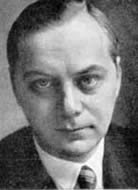 
The Nazi ideologue Alfred
Rosenberg maintained that Christianity could not
provide enough "spiritual energy" for the German
Reich, that was to be established under Hitler's
leadership, and thought it necessary that the
German race return to their ancient pagan
religion. |
Modern fascism, with its roots in the
19th century, is a product of
ideologies that desire to oppose those rules of
morality revealed to man by religion, and to
replace them with a racist, blood-thirsty and
cruel culture of paganism. The neo-Pagan tendency,
which began with the French Revolution, was given
shape by Friedrich Nietzsche, and carried forward
to Nazi ideology. Evolutionists such as Charles
Darwin, Francis Galton and Ernst Haeckel strove to
give so-called scientific support to this rising
paganism, by denying the existence of God, and
attempting to demonstrate that all of life
consists of a "struggle for survival", thus
justifying racism.
 PROPAGANDA BY MEANS OF
ART The Nazis also employed art to re-awaken
paganism. Ancient Greek forms, statues and
symbols suddenly also became a part of German
culture. Portrayals of powerful men and women,
intended to represent the Aryan race, were made
to resemble ancient Greek
statues. |
The American historian, Gene Edward Veith, sums
up these developments in his book Modern Fascism:
Liquidating the Judeo-Christian Worldview this
way: "Fascism is the modern world's nostalgia for
paganism.... It is a sophisticated culture's
revolt against God."30
Nazism clearly revealed that fact. The Nazis
defended paganism, both during the early stages,
and also when they came to power in 1933. They
tore German society away from Christianity, and
tried to turn it to pagan beliefs.
Even in the 1920s, Alfred Rosenberg, the Nazis'
foremost ideologue, was already claiming that
Christianity would be unable to generate
sufficient spiritual energy under the Third Reich
that was to be set up under Hitler's leadership,
and that the German people would have to return to
the old pagan religion. According to Rosenberg,
when the Nazis came to power they would have to
replace all the Christian symbols in churches with
swastikas, copies of Mein Kampf, and swords
symbolizing German invincibility. Hitler was
influenced by these views of Rosenberg, although
he refrained from implementing the so-called
German religion because he was afraid of what
society's reaction might be.31
 Another person who tried
to revive German paganism was Stefan George,
known as one of Germany's great poets, and for
his deviant sexual inclinations towards small
boys. George and his supporters claimed that
Germany would become a new Greek
state.. |
However, important neo-pagan practices were
experimented with during the Nazi era. Not long
after Hitler came to power, Christian holidays and
festivals were replaced by pagan ones. "Mother
Earth" or "Father Sky" were called on at wedding
ceremonies. In 1935, Christian prayers in schools
were stopped, and then all lessons concerning
Christianity were banned.
As made clear in the book The Pink Swastika,
which discusses the Nazis' pagan ideologies (and
homosexual tendencies), "the revival of Hellenic
paganism became a fundamental aspect of the Nazi
identity."32
The same book stresses the fact that there was
a homosexual tendency in that pagan movement which
formed the basis of Nazi identity. It also gives
an interesting example of the Nazis' links to
Greek pagan culture:
 NAZI CEREMONIES WERE IN
IMITATION OF ANCIENT PAGAN
RITES |
Who were these "intellectuals" who popularized
Nietzschean fascism in Germany? Stefan George, one
of Germany's most popular poets of the time, was a
pederast, and "a guiding example" to the Community
of the Special…. "George and his disciples" writes
Oosterhuis and Kennedy "revivified Holderlin's
concept Griechendeutschen (Hellenic Germans)...
His [Stephen George's] last book, Das neue Reich
(The New Kingdom) published in 1928, "prophesied
an era in which Germany would become a new
Greece". In 1933, when Hitler came to power, he
offered George a position as President of the Nazi
Academy of Letters.33
Under Nazi rule, many policies were implemented
that were aimed at establishing a re-awakening of
pagan culture. Schoolchildren were taught the
so-called "Glorious pre-Christian German history,"
and various rites and ceremonies, legacies of
pagan culture, were held all over Germany. All
Nazi meetings were in the form of traditional
pagan ceremonies. There was almost no difference
between Nazi rallies, held under the shadow of
flaming torches, where slogans full of hate and
hostility were shouted and Wagner's pagan music
played, and the perverted ceremonies carried out
thousands of years ago at pagan temples and
altars.
To re-awaken paganism, the Nazis also used the
arts. Ancient Greek concepts and symbols began to
predominate under Nazi rule, and many statues
similar to Greek one were made portraying strong
men and women of the Aryan race. Hitler dreamed
that a "superior race" would be formed through
eugenics, and a cruel and oppressive "world
kingdom" would be established based on the Spartan
model. The expression "The Third Reich" is a
testament to this dream. (Hitler attempted to
found the third and greatest German kingdom after
two others which had existed previously). Because
of this dream, 55 million people lost their lives
in the Second World War, the bloodiest conflict
that the world had ever seen. The genocides Nazis
carried out against various ethnic groups such as
the Jews, Gypsies, and Poles, as well as prisoners
of war from other nations, were of a savagery
unprecedented in history.
In the next chapter, we will see under what
conditions fascism came to power, and how it
proceeded once it had done so.

THE PAGAN
SYMBOLS OF FASCISM
The Nazi symbol of the
swastika is often thought to be a Christian
symbol because of its similarity to the cross.
However, it is actually a pagan symbol
originating from pre-Christian pagan German
beliefs.
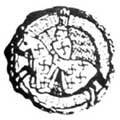 
Liebenfels,
who abandoned Christianity and turned to
paganism, was the first person to use the
swastika in 20th century Nazi Germany. The seal
on the left is from Liebenfels' book cover. The
symbol of the war god Wotan (Odin) was later
taken over by the
Nazis. |
The first person to use
the swastika as a symbol in 20th century Germany
was Jorg Lanz von Liebenfels, one of the
foremost ideologues in the development of Nazi
ideology, who may be regarded as the true
founder of the racist theories concerning the
German race. In his youth he was a Christian
priest, but because of his deviant sexual
tendencies, he was expelled from the Church,
abandoning Christianity and turning to pagan
beliefs. He founded the pagan organization Ordo
Novi Templi (Order of the New Temple), and
announced that they worshipped Wotan, one of the
pagan gods of old German myth. (Wotan, or Odin
in northern languages, was a god of war who rode
an eight-legged horse and carried a spear). Von
Liebenfels wanted to re-instate this aberrant
belief, and announced that he had selected the
swastika as the symbol of Wotan. This pagan
symbol was later taken over by the Nazis, who
also became devoted to the paganism of barbarian
Europe, and who thought they were carrying out
their massacres, conquests and killings in the
name of Wotan.
Adherence to pagan
beliefs may also be discerned in symbols
employed by Mussolini. As mentioned before,
"fascism," which was an invention of
Mussolini's, comes from the Latin word fasces,
that is, a bundle of rods tied around an axe,
used in ancient Rome. Senior officials known as
"lictors" would carry this item before them,
believed to be a symbol of power and
sovereignty.
|
| They are nothing but names which
you yourselves have given, you and your
forefathers. God has sent down no authority for
them. They are following nothing but conjecture
and what their own selves desire. And that when
guidance has reached them from their Lord!
(Koran, 53:23) | |